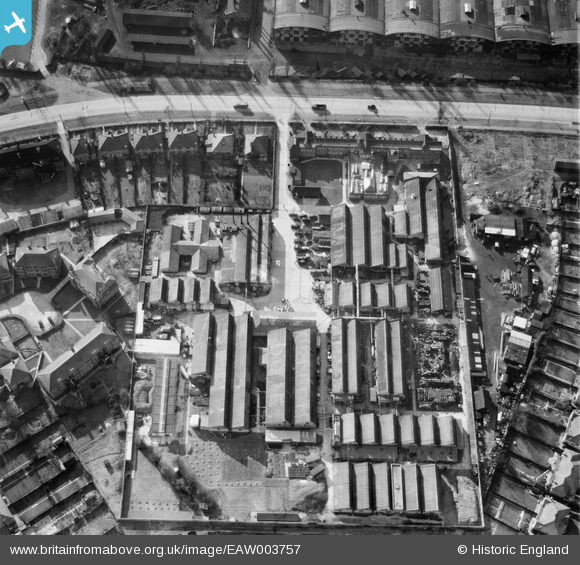© Hawlfraint cyfranwyr OpenStreetMap a thrwyddedwyd gan yr OpenStreetMap Foundation. 2026. Trwyddedir y gartograffeg fel CC BY-SA.
Manylion
| Pennawd |
[EAW003757] The Cellon Chemical Works, Kingston Upon Thames, 1947 |
| Cyfeirnod |
EAW003757 |
| Dyddiad |
18-March-1947 |
| Dolen |
|
| Enw lle |
KINGSTON UPON THAMES |
| Plwyf |
|
| Ardal |
|
| Gwlad |
ENGLAND |
| Dwyreiniad / Gogleddiad |
517885, 171320 |
| Hydred / Lledred |
-0.30412917928883, 51.428116389969 |
| Cyfeirnod Grid Cenedlaethol |
TQ179713 |
Pinnau
 Cellon Ltd., Kingston-on-Thames, has been manufacturing dope ever since flying began in this country, and supplies large quantities to the principal aircraft constructors in this country, and also to the Air Ministry and numerous foreign Governments.
Special attention and research has been devoted to the preparation of protective coverings for the interior and exterior of stressed-skin aircraft. These are of two types:—" Cerric " cellulose lacquers, and " Cerrux " synthetic finishes. Both types are made in the necessary matt surface, and in the required Air Ministry colours.
Other products include:—" Cerric " cellulose adhesives and jointing compounds; " Cerrux " adhesives and jointing compounds; " Cerrex " temporary protectives; " Cerric " dopeproof tape.
Cellon have also patented a process for covering rivets by means of metal strip applied by an anti-corrosive thermo-setting adhesive. This process is being used very largely in the Aircraft Industry. |

Sparky |
Thursday 28th of September 2017 09:10:10 PM |



![[EAW003757] The Cellon Chemical Works, Kingston Upon Thames, 1947](http://britainfromabove.org.uk/sites/all/libraries/aerofilms-images/public/100x100/EAW/003/EAW003757.jpg)
![[EAW003755] The Cellon Chemical Works, Kingston Upon Thames, 1947](http://britainfromabove.org.uk/sites/all/libraries/aerofilms-images/public/100x100/EAW/003/EAW003755.jpg)
![[EAW003763] The Cellon Chemical Works, Kingston Upon Thames, 1947](http://britainfromabove.org.uk/sites/all/libraries/aerofilms-images/public/100x100/EAW/003/EAW003763.jpg)
![[EAW003766] The Cellon Chemical Works and environs, Kingston Upon Thames, from the west, 1947](http://britainfromabove.org.uk/sites/all/libraries/aerofilms-images/public/100x100/EAW/003/EAW003766.jpg)
![[EAW003762] The Cellon Chemical Works, Leyland Motor Works and environs, Kingston Upon Thames, 1947](http://britainfromabove.org.uk/sites/all/libraries/aerofilms-images/public/100x100/EAW/003/EAW003762.jpg)
![[EAW003767] The Cellon Chemical Works, Kingston Upon Thames, 1947](http://britainfromabove.org.uk/sites/all/libraries/aerofilms-images/public/100x100/EAW/003/EAW003767.jpg)
![[EAW003758] The Cellon Chemical Works, Kingston Upon Thames, 1947](http://britainfromabove.org.uk/sites/all/libraries/aerofilms-images/public/100x100/EAW/003/EAW003758.jpg)
![[EAW003765] The Cellon Chemical Works and environs, Kingston Upon Thames, 1947](http://britainfromabove.org.uk/sites/all/libraries/aerofilms-images/public/100x100/EAW/003/EAW003765.jpg)
![[EAW003764] The Cellon Chemical Works and Richmond Road, Kingston Upon Thames, 1947](http://britainfromabove.org.uk/sites/all/libraries/aerofilms-images/public/100x100/EAW/003/EAW003764.jpg)
![[EAW003756] The Cellon Chemical Works, Kingston Upon Thames, 1947](http://britainfromabove.org.uk/sites/all/libraries/aerofilms-images/public/100x100/EAW/003/EAW003756.jpg)
![[EAW003760] The Cellon Chemical Works and environs, Kingston Upon Thames, from the west, 1947](http://britainfromabove.org.uk/sites/all/libraries/aerofilms-images/public/100x100/EAW/003/EAW003760.jpg)
![[EAW003759] The Cellon Chemical Works, Kingston Upon Thames, 1947](http://britainfromabove.org.uk/sites/all/libraries/aerofilms-images/public/100x100/EAW/003/EAW003759.jpg)
![[EAW003754] The Cellon Chemical Works and Tudor Drive, Kingston Upon Thames, 1947](http://britainfromabove.org.uk/sites/all/libraries/aerofilms-images/public/100x100/EAW/003/EAW003754.jpg)
![[EAW003761] The Cellon Chemical Works and environs, Kingston Upon Thames, from the south-west, 1947](http://britainfromabove.org.uk/sites/all/libraries/aerofilms-images/public/100x100/EAW/003/EAW003761.jpg)
![[EPW022854] Leyland Motors Trojan Works, Kingston upon Thames, 1928](http://britainfromabove.org.uk/sites/all/libraries/aerofilms-images/public/100x100/EPW/022/EPW022854.jpg)